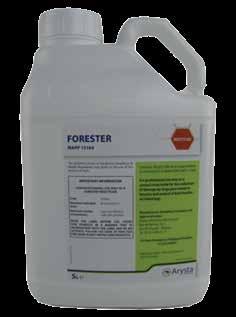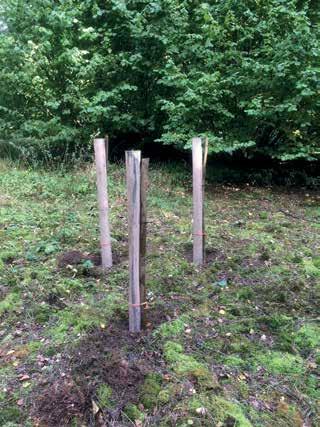
9 minute read
PESTICIDES NOTEBOOK
Pest and weed control in post-Brexit Britain
Product security
The forestry sector can rightly claim that it uses very few pesticides, with less than 3% of the total crop receiving crop protection products in any one year. However, this use is now dominated by the use of two products – glyphosate for weed control, and acetamiprid (Gazelle SG) for hylobius. But how secure are these two products, and if they are withdrawn, are there alternatives?
Worryingly, neither product can be regarded as secure, and glyphosate may be banned in Europe after 2022, with the UK being pressured to follow suit. The use of glyphosate on upland restock sites tends to be focused on scrub control for which there is no current herbicide alternative, although it may be possible in the future to have a triclopyr or fluroxypyr based option. On fertile sites, particularly in the lowland and on new plantings, then Kerb or Laser can be regarded as alternatives for grass control – but both are also far from secure, and non-chemical options are largely too expensive or impractical to implement.
The branding of Gazelle as a neonicotinoid also gives cause for concern, despite not being classified as hazardous to bees, which in any case are rarely found on transplants.
Cypermethrin (Forester) and alphacypermethrin (Alpha 6ED) are currently alternatives which are approved for use in the UK, but the future of these is also in some doubt.
These concerns were recently raised by the Scottish Plant Health Centre, which rated glyphosate, urea, cypermethrin and asulam at high risk of loss, and Kerb, Laser, PG Suspension, Gazelle and Alpha 6ED at medium risk of loss.

Will Brexit have made it more, or less likely that these products will become unavailable?
The UK has transferred the total package of EU pesticide regulation into UK law, so the assessment criteria remain the same, although these are now UK-specific and not directly influenced by pressures from other EU member states. This means that the political pressures on pesticide use in the UK, while serious, are not as powerful as those in the EC, and Ministers have been keen to emphasise that Government decisions are, and will be, based on science.
This does give hope for glyphosate, which ALL worldwide regulatory bodies have classified as non-hazardous and noncarcinogenic. Similarly, if science and not politics prevails, then Gazelle should pass its current re-assessment. We can only wait and see.
Possible requirement for forest managers to have a pesticide qualification
Part of the regulatory package adopted by the UK is to undertake a regularly updated National Action Plan (NAP) of strategies to minimise the use and hazards of pesticide use. The latest NAP has been forwarded to Confor for comment, and requested views provided by 27 questions on three basic areas: Goal 1 - Better Regulation Goal 2 - Promoting the Use of Integrated Pest Management (IPM). Goal 3 - Safe and Responsible Use
In response, Confor made a number of suggestions to simplify and clarify the current regulatory procedure, and highlighted the importance of UKWAS as a voluntary means of promoting best practice including the use of IPM techniques. Also noted were forest strategies to minimise the use of single use plastics (tree tubes & guards as an alternative to herbicides and weevil insecticides), and investment to develop lure and kill options for hylobius control.
However, it was in the “Safe & Responsible Use” section that a major change was indicated.
Currently, in the UK, all spray operators need to carry PA1 & PA6 certification, and all those who sell, or store pesticides for sale or provision to final users must carry BASIS (British Agricultural Supply Industry Scheme) Agronomy or Storekeepers qualifications. However, unlike much of the rest of Europe, no qualification is currently required for those who advise on the use of pesticides, and it is this that Ministers are proposing to change.
This has considerable ramifications for forest managers and consultants who advise clients and instruct contractors over pesticide use, as it is probable that they will need, in future, to demonstrate competence by carrying some form of qualification.
Currently, the only qualification available is the BASIS, which is designed for agronomists, consultants and others whose major focus is on pesticide use. This qualification requires a 28-day training course, an examination, and an annual CPD assessment, all of which is far in excess of the needs of forest practitioners who only spend a tiny amount of their workload on pesticides, and probably only ever refer to two products.
However, the consultation document referred to a scheme which had been developed between the Crop Protection Association and the Horticultural Trades Association for those involved with the sales of amateur pesticides, largely for garden use. Confor noted this scheme and proposed that a similar scheme could be developed for the forest industry, which would be a light touch but nevertheless be able to demonstrate an appropriate level of competency.
As a move towards this solution, a training webinar has been developed, and successfully piloted with one forest management company. Further details of this can be requested by emailing Colin Palmer at forestry@branchline.co.uk
MEMBER SERVICES Pesticides helpline
Pesticides helpline is a free service operated by Confor’s crop protection adviser Colin Palmer on behalf of Confor members. Colin can be contacted 8am to 8pm Mondays to Fridays on 01531 633500 (leave a message if necessary) or by email to: forestry@branchline.co.uk
More planting
Visitors to my wood often ask what new planting I’m doing, especially if I am talking about carrying out a thinning. The thinking goes: if trees are being felled then planting must follow. Of course, readers of this journal will know that is far from reality; thinning is a necessary operation to improve the stand as it grows and develops and to provide some income. But in view of the huge push to increase Britain’s forest cover as part of our climate change response, what role can and should the small woodland owner play?
Ironically, filling in every open space in a woodland is one of the least good things to do for wildlife. As we’ve commented before, biodiversity thrives on diversity. It thrives where there’s plenty of edge, glades, dappled shade beneath the canopy, over-mature trees, and dead wood on the ground and as snags (dead standing trees). So where might extra planting be done, assuming of course your small woodland is already reasonably well wooded? I think there are three situations to get us thinking.
Standards in coppice
Many woodlands have been managed as simple coppice such as hazel or chestnut in the lowlands and oak, once worked for tanbark, in the more hilly and mountainous western side of the British Isles. While most of the oak coppices will have become ‘stored’, ie allowed to grow on long past the coppice rotation age and effectively become high forest, there are many neglected hazel coppices being worked again and chestnut cants cut regularly as simple coppice. Why not introduce standards by planting, say oak, when the next coppicing is done? Only a scattering is required, aiming to have a mature tree about every 20 m. While some loss of coppice productivity occurs more structure is added, large timber is grown, and the aesthetics will mostly improve – the whole stand will become more attractive for wildlife and for all of us to enjoy.
Diversify
Adding standards into coppice diversifies the woodland, but if your wood is a conifer block are there opportunities to plant some broadleaves? Space can be made when next thinning or planning a felling. Equally valuable will be to plant a few conifers in pure broadleaved woodland – as Confor’s ‘Biodiversity, forestry and wood’ report last year illustrated – unless it’s an ancient, semi-natural woodland site where exotics are best avoided. All such diversification increases resilience.
There is another dimension; new planting can introduce new species – what about yew, field maple, wild service or bird cherry – or planting to build resilience with walnuts, cedars and silver firs and other candidates for our future climate?
Advance regeneration
The third situation is when maturing woodland is coming up to final felling and regeneration. While continuous cover principles make the old assumptions of felling and replanting less commonplace, is there room for advance planting of, say, a shade tolerant species such as beech or a silver fir? More generally, as one looks to the future, can planting now help smooth the transition from one stand to its successor? There are numerous variations on this theme, but let’s keep them in the forefront of our minds.
None of the above will massively increase carbon storage by a woodland, but they will help and, at the same time, enrich one’s patch. Many benefits flow from more diversity. As you read this, it’ll be getting late for planting this spring, so let us plan for the autumn to play our part in the national programme to extend our forest cover and make our forests more resilient. Remember, when you plant a tree you are blessing the next generation. Planting of oaks in a gap in hazel coppice, re-using old tree shelters, in the hope one will become a standard.



FORESTRY IN PICTURES

#Netzero visualised
A rare picture which brings together some of today’s hot topics: from reaching #plantingtargets as part of our #netzero commitment, to an ongoing lockdown - with Scotland opting for the extreme measure of open-ended hotel quarantine for incoming or returning travellers. The growing forest and the grounded plane….#COP26
Photo by David Kovalenko on Unplash. Text by Stef Kaiser
Want to see your picture here?
Forestry in Pictures is a regular feature in FTN. For every issue, we select the most impacting photograph sent by a reader. If you have a photo you would like to see published here, please send your file to Stefanie.kaiser@confor.org. Please include your name, brief description of yourself and the picture and a credit. Photos should relate to forestry and timber and be of high-quality (minimum resolution 300dpi). Exceptional pictures might be considered for the front cover of a future FTN issue.
By submitting a picture to Forestry in Pictures you give Confor permission to use the file for non-commercial purposes in Forestry and Timber News or the Confor website. Photos will always be credited.
COMING UP IN JUNE 2021 –
GET INVOLVED
In June, we will run our annual features on Woodfuel and on Innovation and Technology. Remember that FTN is your magazine – get in touch if you want to suggest editorial or give us feedback on articles we have published in the past. Confor members, send us your company’s news updates or pitches for feature articles.
Note that our general editorial deadline for June is 10 May 2021. If you would like to pitch an article idea, please do so by the end of April.










